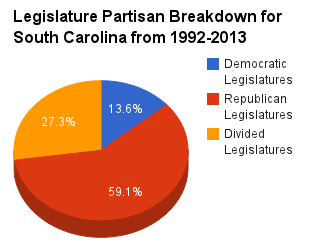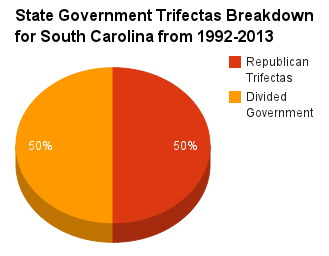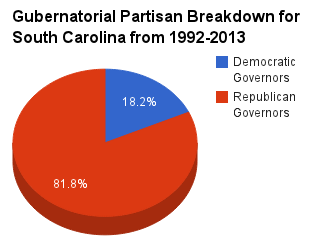Ballotpedia:Who Runs the States, South Carolina
Praise or blame is extended to political parties for the economic, educational, health and other quality of life outcomes that result from the policies those parties enact into law. To better understand which political party enjoys power in each of the states, Ballotpedia has analyzed state government control from 1992-2013 using the concept of a "partisan trifecta." A partisan trifecta is defined as when a state's governorship and legislative chambers are controlled by the same political party.
The two major political parties claim that their policies will lead to better outcomes. What does the data show?
At Ballotpedia, we explored these issues in a three-part study, Who Runs the States.
This page takes a specific look at how South Carolina performed in the study.
Background about the study
- See also: Ballotpedia: Who Runs the States
Part One examines the partisanship of state government from 1992 to 2013. Part Two establishes a State Quality of Life Index (SQLI), aggregating a variety of existing state indices into one measurement. Part Three will overlay the two reports, looking for trends and correlations.
Part 1: Partisanship analysis
South Carolina Governor
From 1992 to 2013, South Carolina had Democratic governors in office for four years while there were Republican governors in office for 18 years, including the last 11. South Carolina is one of eight states that were run by a Republican governor for more than 80 percent of the years between 1992-2013. South Carolina was under Republican trifectas for the final 11 years of the study.
Across the country, there were 493 years of Democratic governors (44.82%) and 586 years of Republican governors (53.27%) from 1992-2013.
Over the course of the 22-year study, state governments became increasingly more partisan. At the outset of the study period (1992), 18 of the 49 states with partisan legislatures had single-party trifectas and 31 states had divided governments. In 2013, only 13 states have divided governments, while single-party trifectas held sway in 36 states, the most in the 22 years studied.
South Carolina Senate
From 1992 to 2013, the Democratic Party was the majority in the South Carolina State Senate for the first nine years while the Republicans were the majority for the last 13 years.
Across the country, there were 541 Democratic and 517 Republican state senates from 1992 to 2013.
South Carolina House of Representatives
From 1992 to 2013, the Democratic Party was the majority in the South Carolina State House of Representatives for the first three years while the Republicans were the majority for the last 19 years. The South Carolina House of Representatives is one of nine state Houses that was Republican for more than 80 percent of the years between 1992 to 2013.
Across the country, there were 577 Democratic and 483 Republican state houses of representatives from 1992 to 2013.
The chart below shows the partisan composition of the Office of the Governor of South Carolina, the South Carolina State Senate and the South Carolina House of Representatives from 1992-2013.
Partisan control changes
There were four partisan control changes in South Carolina during the study period. The average number of changes in the 50 states was four, putting South Carolina equal to the average.
Part 2: State Quality of Life Index (SQLI)
South Carolina’s average ranking over the course of the study period was 44.67, which puts it at 45 in the overall SQLI ranking.[1]
- The year that South Carolina had the highest ranking was 2012, in which it ranked 38th.
- The year that South Carolina had the lowest ranking was 1992, 1993, 1995, 1996, 2004, and 2005, in which it ranked 47th.
- The index type that South Carolina had the highest ranking in was Tax Freedom Day, in which it ranked 4th.
- The index type that South Carolina had the lowest ranking in was Graduation Rate, in which it ranked 50th.
| South Carolina SQLI 1992-2012 | ||||||||||||||||||||||||
|---|---|---|---|---|---|---|---|---|---|---|---|---|---|---|---|---|---|---|---|---|---|---|---|---|
| Index | 1992 | 1993 | 1994 | 1995 | 1996 | 1997 | 1998 | 1999 | 2000 | 2001 | 2002 | 2003 | 2004 | 2005 | 2006 | 2007 | 2008 | 2009 | 2010 | 2011 | 2012 | |||
| 24/7 Wall St Best/Worst Governed States | N/A | N/A | N/A | N/A | N/A | N/A | N/A | N/A | N/A | N/A | N/A | N/A | N/A | N/A | N/A | N/A | N/A | N/A | 44 | 45 | 43 | |||
| America's Health Rankings | 47 | 48 | 46 | 47 | 48 | 44 | 41 | 45 | 45 | 47 | 47 | 45 | 44 | 43 | 43 | 42 | 45 | 46 | 41 | 45 | 46 | |||
| CAFR Debt/GDP | N/A | N/A | N/A | N/A | N/A | N/A | N/A | N/A | N/A | N/A | N/A | N/A | N/A | 34 | 35 | 34 | 33 | 33 | 32 | 31 | N/A | |||
| Chief Executive Magazine Best and Worst States for Business Survey | N/A | N/A | N/A | N/A | N/A | N/A | N/A | N/A | N/A | N/A | N/A | N/A | N/A | 8 | 12 | 8 | 9 | 9 | 10 | 8 | 7 | |||
| CNBC Top States for Business | N/A | N/A | N/A | N/A | N/A | N/A | N/A | N/A | N/A | N/A | N/A | N/A | N/A | N/A | N/A | 29 | 29 | 37 | 31 | 37 | 32 | |||
| Forbes Best States for Business | N/A | N/A | N/A | N/A | N/A | N/A | N/A | N/A | N/A | N/A | N/A | N/A | N/A | N/A | 27 | 23 | 29 | 25 | 34 | 28 | 22 | |||
| Govt. Employment Share Population | 33 | 33 | 31 | 28 | 28 | 28 | 29 | 30 | 29 | 29 | 28 | 27 | 25 | 25 | 24 | 24 | 24 | 24 | 23 | 21 | 24 | |||
| Graduation Rate | 49 | 48 | 48 | 49 | 50 | 50 | 50 | 50 | 49 | 49 | 50 | 50 | 50 | 50 | 50 | 50 | 49 | 48 | 49 | 49 | 47 | |||
| Personal Income Per Capita | 43 | 43 | 42 | 40 | 40 | 38 | 39 | 38 | 39 | 41 | 40 | 41 | 43 | 44 | 45 | 45 | 46 | 47 | 46 | 48 | 48 | |||
| Poverty Rate | 45 | 43 | 29 | 47 | 34 | 29 | 35 | 26 | 33 | 43 | 41 | 33 | 41 | 42 | 25 | 40 | 36 | 29 | 41 | 48 | N/A | |||
| Real GDP per capita | 41 | 40 | 41 | 42 | 42 | 37 | 40 | 39 | 41 | 43 | 43 | 42 | 43 | 45 | 46 | 45 | 47 | 48 | 48 | 48 | N/A | |||
| S&P Credit Rating | N/A | N/A | N/A | N/A | N/A | N/A | N/A | N/A | N/A | 1 | 1 | 1 | 1 | 10 | 10 | 10 | 12 | 12 | 12 | 13 | 14 | |||
| State Govt. Spending/GDP | 39 | 39 | 39 | 35 | 41 | 39 | 38 | 37 | 40 | 42 | 43 | 43 | 43 | 44 | 43 | 44 | 45 | 45 | 43 | 42 | N/A | |||
| State & local tax burden | 10 | 12 | 12 | 11 | 13 | 10 | 14 | 15 | 17 | 14 | 14 | 15 | 17 | 15 | 10 | 13 | 10 | 9 | 10 | N/A | N/A | |||
| Tax Freedom Day | N/A | N/A | N/A | N/A | N/A | N/A | N/A | N/A | N/A | N/A | N/A | N/A | N/A | N/A | N/A | N/A | N/A | N/A | N/A | N/A | 4 | |||
| Unemployment Rate | 21 | 37 | 32 | 23 | 38 | 20 | 16 | 25 | 20 | 38 | 39 | 43 | 47 | 48 | 47 | 45 | 45 | 48 | 45 | 45 | 43 | |||
| Unfunded Pension Liabilities per capita | N/A | N/A | N/A | N/A | N/A | N/A | N/A | N/A | N/A | N/A | N/A | N/A | N/A | N/A | N/A | N/A | N/A | 25 | 24 | 25 | N/A | |||
| Voter Turnout | 50 | 44 | 44 | 49 | 49 | 31 | 31 | 45 | 45 | 40 | 40 | 49 | 49 | 44 | 44 | 40 | 40 | 36 | 36 | 37 | 37 | |||
| Well-Being Index | N/A | N/A | N/A | N/A | N/A | N/A | N/A | N/A | N/A | N/A | N/A | N/A | N/A | N/A | N/A | N/A | 31 | 33 | 35 | 33 | 39 | |||
Part 3: Partisanship and SQLI Overlay
South Carolina was one of eight states to demonstrate a dramatic partisan shift in the 22 years studied. A dramatic shift was defined by a movement of 40 percent or more toward one party over the course of the study period. South Carolina was Republican-dominated during the years of the study but experienced a shift toward much stronger Republican control, resulting in Republican trifectas from 2003-2013.
The chart below depicts the partisanship of the South Carolina state government and the state's SQLI ranking for the years studied. For the SQLI, the states were ranked from 1-50, with 1 being the best and 50 the worst. South Carolina ranked in the bottom-10 during every year of the study except the most recent. In 2012 it improved, finishing at 38th. The state's worst ranking, finishing 47th, occurred during both divided government and Republican trifectas.
- SQLI average with Democratic trifecta: N/A
- SQLI average with Republican trifecta: 44.30
- SQLI average with divided government: 45.00
See also
- Ballotpedia:Who runs the states
- Governor of South Carolina
- South Carolina State Senate
- South Carolina House of Representatives
Additional information
External links
Footnotes
- ↑ Note: The average rank is compiled by adding up all years of rankings and then dividing by 21 to obtain the average state ranking. This average figure is ranked relative to the rest of the 49 states to derive an overall SQLI ranking.
 |
State of South Carolina Columbia (capital) |
|---|---|
| Elections |
What's on my ballot? | Elections in 2025 | How to vote | How to run for office | Ballot measures |
| Government |
Who represents me? | U.S. President | U.S. Congress | Federal courts | State executives | State legislature | State and local courts | Counties | Cities | School districts | Public policy |





